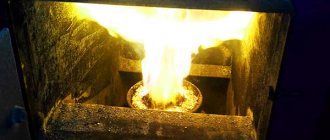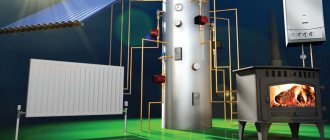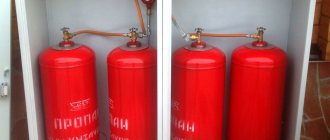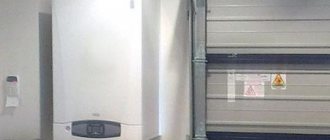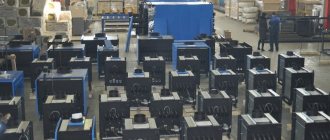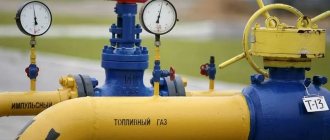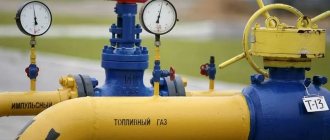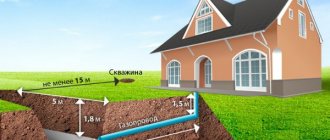Gas installations for heating a home are beneficial in terms of savings. In addition, the automatic heating process almost completely eliminates the use of human labor. The overall benefit from using gas heating systems is calculated individually.
For example, gas consumption for heating a house of 150 m2 depends on the power indicators of the equipment. The higher the power, the higher the fuel consumption. The total amount of gas consumption can be calculated by multiplying the power of the equipment by 720 (the average number of hours per month). You should remember about the approximate correctness of the data obtained, because the time of use directly depends on the temperature, latitude zone, and insulation of the house.
In most calculations, it is recommended to calculate the average monthly consumption - to do this, the total number from the previous formula is divided in half.
How to calculate the need for thermal energy
The simplified formula for this calculation looks very simple - 1 kW of thermal energy is spent on heating 10 m2 of building area. A more accurate formula operates not with areas, but with the cubic capacity of the house, also taking into account the height of the ceilings in the room. But for standard-type dwellings with a ceiling height of 2.5-2.7 meters, the above simplified proportion is valid. An accurate calculation of the need for thermal energy operates not only on the volume of heated space, but also on the heat resistance of walls, openings and ceilings. In addition, in this case, the average annual temperature and other nuances are taken into account.
Boiler room
However, in order to calculate the volume of fuel, a simple formula will be enough for us: 1 kilowatt = 10 square meters. As a result, heating a building with an area of 150 or 200 square meters requires spending 15 or 20 kW, respectively. And this is only an hour. But the boiler does not consume gas every minute. The work/downtime period here is divided in the proportion of 50/50 percent. Therefore, per day, a house with an area of 150 square meters will spend 180 kW (15x24/2), and a home with an area of two hundred square meters will spend 240 kW.
The cold season in our latitudes lasts from October to April - 7 months or 210 days. Therefore, annual thermal energy consumption will be 37,800 and 50,400 kW. We will focus on these values in our further calculations.
How to reduce fuel consumption for the owner of a private house
The amounts mentioned above can stun an impressionable tenant or an ordinary citizen. Well, what can you do - “your own home” was an expensive pleasure at all times. However, unlike a city dweller living in an apartment, the owner of a private home can change heating costs in his favor.
Insulating your home will help reduce heating costs
To do this, he will need to do the following:
- Insulate the facade, foundation, roof, attic and basement floors - even a thin layer of thermal insulation material can make up at least a couple thousand, or even a whole ten, from the gas bill.
- Replacing old windows with modern double-glazed windows, installing a heat-resistant panel in the doorway is another 5-10 thousand minus. Moreover, doors and windows should be tackled first, since they generate at least 40 percent of heat losses.
- Install a heat accumulator in the basement or boiler room, change the wiring diagram to a double-circuit or manifold version, which provides the possibility of point thermoregulation of radiators, purchase a boiler with high efficiency. Now there are excellent 95% devices on sale. In this case, savings can be up to 10-15 percent of the total bill.
In short, it is necessary, firstly, to increase the heat resistance of the house, and secondly, to use more energy-efficient equipment. And no one is forcing you to make these changes in one season. You can start with windows, then improve the boiler and get to the walls and ceilings. As a result, you can save up to a quarter of the stated costs.
How much heat does liquefied or natural gas give off?
We already know the annual consumption of the heating system. Now we must calculate the calorific value of the energy source itself - liquefied and natural gas. Using these values, we can come up with the amount of substance burned in the firebox of a gas boiler per year.
Calorific value is the ratio of the amount of kilowatt of energy released during fuel oxidation to a unit of mass or volume. Since we are interested in main (natural) or liquefied gas used for heating the house as an energy source, we will use cubic meters or liters as a measure of the substance. According to the tabular data, the calorific value of natural gas is 33.5 MJ/m3 or 9.3 kW/m3 (a coefficient of 1 kW = 3.6 MJ is used for conversion). That is, when a cube of gas is burned, 9.3 kW of thermal energy is released.
Liquefied gas is a mixture of propane, ethylene and other flammable carbohydrates. And it is more “caloric” than dietary natural fuel. According to tabular data, the calorific value of a kilogram of such a substance is 45.20 MJ or 12.5 kW. But the generally accepted “unit of measurement” for liquefied fuel is liters, and its density is 0.524 kg/l. Therefore, we can say that when a liter of liquefied mixture is burned, 6.55 kW of thermal energy is released.
Which gas to choose - which is more profitable?
To connect to the main gas pipeline, the user will have to pay for the project and installation work. And these expenses cannot be called insignificant. The growing appetites of gas services make gasification of homes a very expensive undertaking. However, all these expenses pay off during operation. As of March 2022, the cost of a cubic meter of gas, depending on the region of the Russian Federation, ranges from 4.44 to 8.66 rubles. The average price is 6.55 rubles. As a result, heating a house with natural gas of 150 or two hundred square meters, taking into account the estimated consumption rate for the season, will cost 29,825 and 39,038 rubles.
Liquefied fuel does not require insertion into the main line, but to store it it is necessary to build a gas tank - a container that accepts the required volume of fuel. In addition, this container will have to be periodically filled with gas, which is delivered to the site using special transport, and this service is not cheap. And the gas tank will have to be repaired and maintained. After all, the safety of all residents of a house heated by liquefied gas depends on its condition.
Liquefied fuel storage
At the beginning of spring 2022, a liter of liquefied gas at gas stations cost from 11 to 20 rubles, depending on the region of the Russian Federation. The average cost of this fuel was 15.5 rubles. Therefore, heating a 150-square-meter house with liquefied gas will cost 98,394 rubles. For housing with an area of two hundred square meters you will have to pay even more - 131,192 rubles. As you can see, liquefied fuel has surpassed natural gas in cost by 3.3 times. Therefore, conclusions regarding whether it is profitable or unprofitable suggest themselves - natural (main) gas, with all the bureaucracy and complexity of the connection process, will be much more profitable than liquefied fuel.
Types of gas
Heating private houses and cottages with an area of over 150 square meters requires a large amount of fuel. For this reason, when choosing a suitable coolant, one should take into account not only the degree of its heat transfer, but also the economic benefits of its use and the profitability of equipment installation. Gas best meets the listed parameters.
For a larger room area, more fuel is needed
Types of gas:
- Natural. It combines hydrocarbons of various types with a predominant proportion of methane CH4 and impurities of non-hydrocarbon origin. When one cubic meter of this mixture is burned, more than 9 kW of energy is released. Since gas is naturally located underground in certain rock layers, special pipelines are laid for its transportation and delivery to consumers. In order for natural gas to flow into the house and heat it, it is necessary to connect to such a pipeline. All connection work is carried out exclusively by gas service specialists. Their work is valued quite highly, so tapping into a gas main can cost a large sum.
- Liquefied. Includes substances such as ethylene, propane and other flammable additives. It is usually measured not in cubic meters, but in liters. One liter, when burned, produces about 6.5 kW of heat. Its use as a coolant does not imply an expensive connection to the main pipeline. But to store liquefied fuel, it is necessary to equip a special container. As gas is consumed, its volume will have to be replenished in a timely manner. The cost of transportation must be added to the cost of a permanent purchase.
Once the choice in favor of one or another type of fuel has been made, you can determine the gas consumption for heating a house of 150 m². A special formula should be used for calculation.
You will see the principles of heating with liquefied gas cylinders in this video:
Pros and cons of heating systems
And now, friends, let’s look at the most interesting thing - the pros and cons of these systems, so that each of you can decide and understand what to use for your country house, for your heating system.
The first option is natural gas. Natural gas is the cheapest form of heating. If you are lucky and managed to connect it, then you don’t even have to consider all other options. If you do not have the opportunity to connect natural gas, or it is very far away, and the cost of its supply costs a lot of money, or you are running out of time, and you need to connect to heating as quickly as possible, and connecting natural gas takes about 1 year to 1.5 years, then this option is not for you. When you need heating tomorrow, and you have to run through authorities, it does not cause any pleasure, even taking into account the subsequent savings.
Let's look at three heating options that can be used alternatively, autonomously, quickly.
Volume of consumption
Despite the fact that both coolants are gas, heating the same room will require different amounts of fuel. To calculate the amount of fuel consumed in 1 hour (A), it is necessary to take into account:
- equipment power (Q);
- specific heat of gas of a particular brand (q);
- efficiency factor of the gas installation (B).
Heating one room requires different amounts of natural and liquefied gas
We recommend: Thermal imager for the home: examination features
To calculate, you should use the formula A = Q / q * B. If you substitute all the available values into it, it is easy to determine that for an area of 150 m² you will need 0.836 liters of natural gas per hour, for an area of 200 m² - 1.114 liters. In the case of liquefied gas, the amount of fuel will be 1.168 and 1.558 liters per hour, respectively. The average daily level of consumption is obtained by multiplying these figures by 24 hours, the monthly - by multiplying the average daily by 30 (31) days.
If a house heated by gas has several rooms, then the volume of its consumption should be calculated for each room separately. In this case, it is necessary to take into account the average temperature during the coldest time of the year.
Since the temperature regime will change from negative to positive throughout the year, during the calculation process its average will need to be divided in half.
Calculation method for natural gas
The approximate gas consumption for heating is calculated based on half the power of the installed boiler. The thing is that when determining the power of a gas boiler, the lowest temperature is set. This is understandable - even when it is very cold outside, the house should be warm.
You can calculate gas consumption for heating yourself
But calculating gas consumption for heating using this maximum figure is completely incorrect - after all, the temperature is generally much higher, which means much less fuel is burned. That’s why it is generally accepted that the average fuel consumption for heating is about 50% of the heat loss or boiler power.
We calculate gas consumption by heat loss
If you don’t have a boiler yet, and you estimate the cost of heating in different ways, you can calculate it from the total heat loss of the building. They are most likely known to you. The technique here is this: they take 50% of the total heat loss, add 10% to provide hot water supply and 10% to remove heat during ventilation. As a result, we obtain the average consumption in kilowatts per hour.
Next, you can find out the fuel consumption per day (multiply by 24 hours), per month (by 30 days), and, if desired, for the entire heating season (multiply by the number of months during which the heating operates). All these figures can be converted into cubic meters (knowing the specific heat of combustion of gas), and then multiply the cubic meters by the price of gas and, thus, find out the heating costs.
| Natural gas | 1 m 3 | 8000 kcal | 9.2 kW | 33.5 MJ |
| Liquefied gas | 1 kg | 10800 kcal | 12.5 kW | 45.2 MJ |
| Coal (W=10%) | 1 kg | 6450 kcal | 7.5 kW | 27 MJ |
| Wood pellets | 1 kg | 4100 kcal | 4.7 kW | 17.17 MJ |
| Dried wood (W=20%) | 1 kg | 3400 kcal | 3.9 kW | 14.24 MJ |
Example of heat loss calculation
Let the heat loss of the house be 16 kW/hour. Let's start counting:
- average heat demand per hour - 8 kW/h + 1.6 kW/h + 1.6 kW/h = 11.2 kW/h;
- per day - 11.2 kW * 24 hours = 268.8 kW;
- per month - 268.8 kW * 30 days = 8064 kW.
The actual gas consumption for heating also depends on the type of burner - modulating ones are the most economical
Convert to cubic meters. If we use natural gas, we divide the gas consumption for heating per hour: 11.2 kW/h / 9.3 kW = 1.2 m3/h. In calculations, the figure 9.3 kW is the specific heat capacity of natural gas combustion (available in the table).
By the way, you can also calculate the required amount of fuel of any type - you just need to take the heat capacity for the required fuel.
Since the boiler has not 100% efficiency, but 88-92%, you will have to make further adjustments for this - add about 10% of the obtained figure. In total, we get gas consumption for heating per hour - 1.32 cubic meters per hour. Next you can calculate:
- consumption per day: 1.32 m3 * 24 hours = 28.8 m3/day
- monthly demand: 28.8 m3/day * 30 days = 864 m3/month.
The average consumption for the heating season depends on its duration - multiply by the number of months while the heating season lasts.
This calculation is approximate. In some months, gas consumption will be much less, in the coldest month - more, but on average the figure will be about the same.
Boiler power calculation
The calculations will be a little simpler if you have the calculated boiler power - all the necessary reserves (for hot water supply and ventilation) have already been taken into account. Therefore, we simply take 50% of the calculated capacity and then calculate the consumption per day, month, per season.
For example, the design power of the boiler is 24 kW. To calculate gas consumption for heating, we take half: 12 k/W. This will be the average heat demand per hour. To determine fuel consumption per hour, we divide by the calorific value, we get 12 kW/hour / 9.3 k/W = 1.3 m3. Then everything is calculated as in the example above:
- per day: 12 kW/h * 24 hours = 288 kW in terms of the amount of gas - 1.3 m3 * 24 = 31.2 m3
- per month: 288 kW * 30 days = 8640 m3, consumption in cubic meters 31.2 m3 * 30 = 936 m3.
You can calculate gas consumption for heating a house using the design capacity of the boiler
Next, add 10% for the imperfection of the boiler, we find that for this case the consumption will be slightly more than 1000 cubic meters per month (1029.3 cubic meters). As you can see, in this case everything is even simpler - fewer numbers, but the principle is the same.
By quadrature
Even more approximate calculations can be obtained based on the square footage of the house. There are two ways:
- You can calculate according to SNiP standards - on average, heating one square meter in Central Russia requires 80 W/m2. This figure can be used if your house is built according to all requirements and has good insulation.
- You can estimate based on average statistical data: with good insulation of the house, 2.5-3 cubic meters/m2 is required;
- with average insulation, gas consumption is 4-5 cubic meters/m2.
The better the house is insulated, the lower the gas consumption for heating will be.
Each owner can assess the degree of insulation of his home; accordingly, one can estimate what gas consumption will be in this case. For example, for a house of 100 sq. m. with average insulation, 400-500 cubic meters of gas will be required for heating, for a house of 150 square meters it will take 600-750 cubic meters per month, for heating a house with an area of 200 m2 - 800-100 cubic meters of blue fuel. All this is very approximate, but the figures are derived based on many factual data.
Heating of country cottages
When calculating the gas consumption needed to heat a house, the most difficult task will be calculating the heat loss, which the heating system must fully compensate for during operation.
The complex of heat losses depends on the climate, the design features of the building, the materials used and the operating parameters of the ventilation system.
Calculation of the compensated amount of heat
The heating system of any building must compensate for its heat loss Q (W) during the cold period. They happen for two reasons:
- heat exchange through the perimeter of the house;
- heat loss as a result of cold air entering through the ventilation system.
Formally, heat loss through the wall and roof Qtp can be calculated using the following formula:
Qtp = S * dT / R,
Where:
- S – surface area (m2);
- dT – temperature difference between room and street air (°C);
- R – indicator of heat transfer resistance of materials (m2 * °C / W).
The last indicator (which is also called the “thermal resistance coefficient”) can be taken from the tables attached to the building materials or products.
The heat loss rate of the house significantly depends on the type of double-glazed window. The high price of insulated windows will be justified due to fuel savings
Example. Let the outer wall of the room have an area of 12 m2, of which 2 m2 is occupied by the window.
The heat transfer resistance indicators are as follows:
- Aerated concrete blocks D400: R = 3.5.
- Double-glazed window with argon “4M1 – 16Ar – 4M1 – 16Ar – 4I”: R = 0.75.
In this case, at room temperature “+22°С”, and street temperature – “–30°С”, the heat loss from the outer wall of the room will be:
- Qtp (wall) = 10 * (22 – (– 30)) / 3.5 = 149 W:
- Qtp (window) = 2 * (22 – (– 30)) / 0.75 = 139 W:
- Qtp = Qtp (wall) + Qtp (window) = 288 W.
This calculation gives the correct result provided there is no uncontrolled air exchange (infiltration).
It may occur in the following cases:
- The presence of structural defects, such as loose fitting of window frames to the walls or peeling of insulating material. They need to be eliminated.
- Aging of a building, resulting in chips, cracks or voids in the masonry. In this case, it is necessary to introduce correction factors into the heat transfer resistance of materials.
In the same way, it is necessary to determine heat loss through the roof if the object is located on the top floor. Through the floor, any significant energy loss occurs only if there is an unheated, ventilated basement space, such as a garage. Almost no heat goes into the ground.
To calculate the heat transfer resistance index of multilayer materials, it is necessary to sum up the indicators of individual layers. Usually, only the most non-thermal conductive materials are taken for calculations
Let's consider the second reason for heat loss - building ventilation. Energy consumption for heating the supply air (Qв) can be calculated using the formula:
Qв = L * q * c * dT , where:
- L – air flow (m3/h);
- q – air density (kg/m3);
- c – specific heat capacity of incoming air (kJ/kg *°C);
- dT – temperature difference between room and street air (°C).
The specific heat capacity of air in the temperature range of interest to us [–50.. +30 °C] is equal to 1.01 kJ / kg * °C or, translated to the dimension we need: 0.28 W * h / kg * °C. Air density depends on temperature and pressure, but for calculations you can take a value of 1.3 kg / m3.
Example. For a room of 12 m2 with the same temperature difference as in the previous example, heat loss due to ventilation will be:
Qв = (12 * 3) * 1.3 * 0.28 * (22 – (– 30)) = 681 W.
Designers take air flow according to SNiP 41-01-2003 (in our example, 3 m3 / h per 1 m2 of living room area), but this value can be significantly reduced by the owner of the building.
In total, the total heat loss of the model room is:
Q = Qtp + Qb = 969 W.
To calculate heat loss per day, week or month, you need to know the average temperature for these periods.
From the above formulas it is clear that the calculation of the volume of gas consumed both for a short period of time and for the entire cold season must be carried out taking into account the climate of the area where the heated facility is located. Therefore, well-proven standard solutions can only be used for similar natural conditions.
To determine similar climatic parameters, you can use maps of average monthly temperatures in winter. They can be easily found on the Internet
With the complex geometry of the house and the variety of materials used in its construction and insulation, you can use the services of specialists to calculate the required amount of heat.
Ways to minimize heat loss
The cost of heating a home makes up a significant portion of the cost of maintaining it. Therefore, it is reasonable to carry out some types of work aimed at reducing heat loss by insulating the ceiling, walls of the house, insulating the floor and adjacent structures.
The use of insulation schemes outside and inside the house can significantly reduce this figure. This is especially true for old buildings with severe wear and tear on walls and ceilings. The same polystyrene foam boards can not only reduce or completely eliminate freezing, but also minimize air infiltration through the protected coating.
Significant savings can also be achieved if the summer areas of the house, such as verandas or the attic floor, are not connected to heating. In this case, there will be a significant reduction in the perimeter of the heated part of the house.
Using the attic floor only in the summer significantly saves the cost of heating the house in winter. However, in this case, the ceiling of the upper floor must be well insulated
If you strictly follow the standards for ventilation of premises, which are prescribed in SNiP 41-01-2003, then heat loss from air exchange will be higher than from freezing of the walls and roof of the building. These rules are mandatory for designers and any legal entities if the premises are used for production or provision of services. However, residents of the house can, at their discretion, reduce the values specified in the document.
In addition, to heat the cold air coming from the street, you can use heat exchangers, rather than devices that consume electricity or gas. Thus, an ordinary plate heat exchanger can save more than half of the energy, and a more complex device with coolant can save about 75%.
Heating a house with a gas holder
It is better to calculate the required amount of gas in relation to the barrel. That is, how long will each container last for different room sizes?
The gas tank is selected according to the number of refills. The optimal rate is 1-2 times a year. At a minimum, the tank should last for 7–8 months—the heating season.
Liquefied gas consumption per season
According to SP 131.13330.2012 Construction Climatology (updated edition of SNiP 23-01-99), the heating season in Russia is 207 days. This is approximately 7 months.
Also important information: the boiler does not operate around the clock. On average, heating operates 10 hours a day.
We carried out calculations based on the initial data:
- brick house without attic and basement;
- floor height 3.2 m;
- The efficiency of the gas boiler is 92%.
Indicators for refueling frequency are averaged. We assumed the same fuel costs for each month. In reality, residence may be seasonal or temporary, and consumption differs depending on the season.
The ratio of the area of the house and the volume of the gas tank (GG)
| GG volume (m3) | Full gas charge (l) | How long will gas last (months) | |||||||
| 50–100 m2 | 150 m2 | 200 m2 | 250 m2 | 300 m2 | 350–450 m2 | 500–600 m2 | 800 m2 | ||
| 3,802 l/year | 5,703 l/year | 7,603 l/year | 9,504 l/year | 11,405 l/year | 17,107 l/year | 22,809 l/year | 30,412 l/year | ||
| 2.5 | 2 125 | 6.7 | 4.5 | 3 | 2.7 | 2 | 1.5 | 1.1 | 0.8 |
| 2.7 | 2 295 | 7 | 5 | 3.6 | 3 | 2.4 | 1.6 | 1.2 | 0.9 |
| 4.6 | 3 910 | 12 | 8 | 6 | 5 | 4 | 2.7 | 2 | 1.5 |
| 4.8 | 4 080 | 12.8 | 8.5 | 6.4 | 5.1 | 4.2 | 2.8 | 2.1 | 1.6 |
| 4.85 | 4 112 | 13 | 8.6 | 6.5 | 5.2 | 4.3 | 2.9 | 2.2 | 1.6 |
| 5 | 4 250 | 13.4 | 9 | 7 | 5.4 | 4.5 | 3 | 2.2 | 1.7 |
| 6.4 | 5 440 | 17 | 11.4 | 8.5 | 6.8 | 5.7 | 3.8 | 2.8 | 2.1 |
| 6.5 | 5 525 | 17.4 | 11.6 | 8.7 | 6.9 | 5.8 | 3.9 | 2.9 | 2.2 |
| 6.6 | 5 610 | 17.6 | 12 | 9 | 7 | 6 | 4 | 3 | 2.2 |
| 8.6 | 7 310 | 23 | 15 | 11.5 | 9 | 7.7 | 5 | 3.8 | 2.9 |
| 9.1 | 7 735 | 24.4 | 16 | 12 | 9.7 | 8 | 5.4 | 4 | 3 |
| 9.15 | 7 777 | 24.5 | 16.4 | 12.3 | 9.8 | 8.2 | 5.5 | 4.1 | 3.1 |
| 9.6 | 8 160 | 25.7 | 17 | 13 | 10 | 8.6 | 5.7 | 4.3 | 3.2 |
| 10 | 8 500 | 27 | 18 | 13.4 | 10.7 | 9 | 6 | 4.5 | 3.4 |
Interpretation of colors in the table:
| irrational | Capacity supply is too large or too small |
| optimal | For seasonal or permanent residence with 2 refills per year |
| perfect | It is best to install for the heating season |
| with reserve | One-time refill is enough for a year |
Houses with an area of 800–1000 m2 are served by:
- gas tanks with industrial volumes of more than 10 m3 (installation is more complicated);
- two containers located side by side (8.6, 9.1 or 9.15 m3).
Liquefied gas consumption per month and year
Let's go over the costs of refilling a gas tank for houses of different sizes. We use the LPG price current at the beginning of 2022 - 17.80 rubles/l. This is the cost of refueling in our company.
House area (m2) Gas consumption per month (l) Gas price per month (rub.) Gas consumption per year (l) Gas price per year (rub.)
| 50–100 | 316 | 5 624 | 3 802 | 67 675 |
| 150 | 475 | 8 455 | 5 703 | 101 153 |
| 200 | 633 | 11 267 | 7 603 | 135 533 |
| 250 | 792 | 14 097 | 9 504 | 169 171 |
| 300 | 950 | 16 910 | 11 405 | 203 009 |
| 350–450 | 1 425 | 15 365 | 17 107 | 304 504 |
| 500–600 | 1 900 | 33 820 | 22 809 | 406 000 |
| 800 | 2 534 | 45 105 | 30 412 | 541 334 |
Thus:
- gas consumption for heating a house of 100 m2 is 68 thousand rubles per year;
- gas consumption for heating a house of 150 m2 is 101 thousand rubles per year;
- gas consumption for heating a house of 200 m2 is 136 thousand rubles per year.
A gas boiler
Having made a preliminary calculation of the fuel consumed, many choose the liquefied type and install a gas boiler in their home. This choice is determined by the following factors:
- Long service life. Liquefied fuel does not destroy the material from which boilers are made, so they last for quite a long time.
- Easy installation. If we compare the process of connecting to a gas pipeline and the process of installing individual gas equipment, the second is much easier and faster.
- Economic benefit. Since heating the same room requires less liquefied gas than mains gas, its use will be more economical (especially in cases with large houses exceeding 200 m²).
- Properties. Fuel in cylinders has better characteristics. When it burns, no hazardous substances are released. The minimum sulfur content guarantees high combustion efficiency.
- Safety. Autonomous units are equipped with modern systems that prevent fuel leakage and explosion in the event of a breakdown.
A gas boiler is economical and safe.
With all its advantages, autonomous heating equipment is not without some disadvantages. These include the need to regularly refill cylinders, the influence of atmospheric pressure on the operation of the system, and the inability to operate during a power outage.
The main part of any autonomous gas heating system is a gas tank . This is a container into which liquefied gas is pumped. The amount of thermal energy released by the gas during combustion directly depends on the area for evaporation of the gas tank. This area inside the tank is called a mirror. If the 4.8 ton tank is fully filled, this volume will be enough for a period of about 200 days.
In addition to the size of the mirror, the volume of heat generated is affected by the design of the heating system, the number and area of the radiators included in it, climatic conditions and other factors.
Is it profitable to install autonomous heating?
The cost of purchasing, installing and setting up autonomous heating equipment that runs on a mixture of propane and butane is much lower than connecting to the main line.
This system also significantly reduces the risk of a sudden drop in pressure. Autonomous heating is equipped with tanks that keep the fuel available after it runs out in the main tank.
In the event of a power outage or gas supply, the safety system will block the solenoid valve. Once the supply is restored, the system must be restarted.
What increases gas consumption
Gas consumption for heating, in addition to its type, depends on the following factors :
- Climatic features of the area. The calculation is carried out for the lowest temperature indicators characteristic of these geographical coordinates;
- The area of the entire building, its number of floors, the height of the rooms;
- Type and presence of insulation of the roof, walls, floor;
- Type of building (brick, wood, stone, etc.);
- The type of profile on the windows, the presence of double-glazed windows;
- Organization of ventilation ;
- Power in the limit values of heating equipment.
The year the house was built and the location of the heating radiators are also important.
Reducing consumption
This is known: if you insulate your house well, the fuel consumption for heating will be significantly reduced. Therefore, before selecting and installing equipment and laying main routes, it is necessary to properly insulate the house: walls, roof and attic, floor, replace windows, and make an airtight sealing loop on the doors.
Particular attention should be paid to the roof and windows. It is assumed that out of 100% of lost heat, 35% goes through the roof, about 25% is lost at the windows. Therefore, use the best thermal insulation materials and good double-glazed windows, which have a low thermal conductivity coefficient. Cheap double-glazed windows are immediately obvious: their aluminum or steel “skeleton” is always very cold in winter, and a lot of heat is lost directly through it. Even the glass itself does not transmit heat as much as the metal profile on which the glass is held does.
How to reduce gas consumption
A well-known rule: the better the house is insulated, the less fuel is used to heat the street. Therefore, before starting the installation of the heating system, you should perform high-quality thermal insulation of the house - roof/attic, floors, walls, replacement of windows, airtight sealing loop on the doors.
You can also save fuel due to the heating system itself. By using heated floors instead of radiators, you will get more efficient heating: since heat spreads by convection currents from bottom to top, the lower the heating device is located, the better.
In addition, the standard temperature of floors is 50 degrees, and radiators are on average 90. Obviously, floors are more economical.
Finally, you can save gas by adjusting the heating according to time. There is no point in actively heating a house when it is empty. It is enough to maintain a low positive temperature so that the pipes do not freeze.
Modern boiler automation (types of automation for gas heating boilers) allows remote control: you can give a command to change the mode through a mobile provider before returning home (what are Gsm modules for heating boilers). At night, the comfortable temperature is slightly lower than during the day, etc.
How to save money?
The financial costs of maintaining a comfortable microclimate in the house can be reduced by
:
- additional insulation of all structures, installation of windows with double-glazed windows and door structures without cold bridges;
- installation of high-quality supply and exhaust ventilation (an incorrectly executed system can cause increased heat loss);
- use of alternative energy sources - solar panels, etc.
Separately, it is worth paying attention to the advantages of the collector heating system and automation, thanks to which the optimal temperature level is maintained in each of the rooms. This allows you to reduce the load on the boiler and fuel consumption when the weather warms up outside, and reduce the heating of the coolant that is supplied to radiators or a heated floor system in unused rooms.
If the house has a standard radiator system, a sheet of thin foam heat insulator with an outer foil surface can be glued to the wall behind each heating device. Such a screen effectively reflects heat, preventing it from escaping through the wall to the street.
A set of measures aimed at increasing the thermal efficiency of a home will help minimize energy costs.
How to avoid heat loss
Fuel consumption for heating a house depends on the total area of the heated premises, as well as the heat loss coefficient. Any building loses heat through the roof, walls, window and door openings, and the floor of the lower floor.
Accordingly, the level of heat loss depends on the following factors
:
- climate features;
- wind roses and the location of the house relative to the cardinal directions;
- characteristics of the materials from which building structures and roofing are constructed;
- presence of a basement/ground floor;
- quality of insulation of floors, wall structures, attic floors and roofs;
- quantity and tightness of door and window structures.
Thermal calculation of the house allows you to select boiler equipment with optimal power parameters. In order to determine the heat requirement as accurately as possible, the calculation is performed for each heated room separately. For example, the heat loss coefficient is higher in rooms with two windows, in corner rooms, etc.
Note! The boiler power is selected with some margin relative to the calculated values obtained. The boiler unit wears out faster and fails if it regularly operates at its maximum capacity. At the same time, excessive power reserves result in increased financial costs for the purchase of a boiler and increased fuel consumption.
How to calculate main gas consumption
The calculation of gas consumption for heating a private home depends on the power of the equipment (which determines the gas consumption in gas heating boilers). Power calculation is performed when choosing a boiler. Based on the size of the heated area. They calculate for each room separately, focusing on the lowest average annual temperature outside.
To determine energy consumption, the resulting figure is divided approximately in half: because throughout the season, the temperature fluctuates from severe minus to plus, gas consumption varies in the same proportions.
When calculating power, the ratio is based on the ratio of kilowatts per ten square meters of heated area. Based on the above, we take half of this value - 50 watts per meter per hour. At 100 meters – 5 kilowatts.
Fuel is calculated using the formula A = Q / q * B, where:
- A – the required amount of gas, cubic meter per hour;
- Q – power required for heating (in our case 5 kilowatts);
- q – minimum specific heat (depending on the type of gas) in kilowatts. For G20 – 34.02 MJ per cubic meter = 9.45 kilowatts;
- B is the efficiency of our boiler. Let's say 95%. The required figure is 0.95.
We substitute numbers into the formula, and for 100 m2 we get 0.557 cubic meters per hour. Accordingly, the gas consumption for heating a house of 150 m2 (7.5 kilowatts) will be 0.836 cubic meters, the gas consumption for heating a house of 200 m2 (10 kilowatts) will be 1.114, etc. It remains to multiply the resulting figure by 24 - you get the average daily consumption, then by 30 - the average monthly.
Calculation formula for main fuel
The power of the boiler affects gas consumption in a private home, so the owner must first calculate the fuel consumption, focusing on gas equipment. The area of the cottage is also taken into account. Each room is calculated separately, based on the average annual street temperature and starting from the obtained minimum value.
To calculate gas consumption, the identified number must be divided by 2, since each winter season has different air temperatures. In the northern regions, it can reach serious disadvantages; accordingly, resource consumption will be higher than in the southern regions.
According to all the rules, it is calculated as follows: the ratio is 1 kW per 10 sq. m. area of the house. Divide the resulting number in half, resulting in 50 watts for 60 minutes of heating. A house with an area of 100 m² will consume approximately 5 kW. Formula for calculating gas consumption in a private home (A=Q/q*B):
- A - cubic meter of resource consumption in 60 minutes;
- Q is the power of equipment for heating the house, in this case 5 kW;
- q - determines the minimum specific heat, it all depends on the type of fuel, for example, for G20 - 34.02 MJ per 1 cubic meter comes out to almost 10 kW;
- B is the efficiency of the equipment, for example, it works at 90%, which means they take the figure at 0.90.
All that remains is to substitute the required numbers instead of the letters in the formula. In this case, gas consumption per 100 sq. m. will be like this: 0.560 cubic meters per 60 minutes of boiler operation. For heating a room with an area of 150 sq. m. it will turn out to be 0.840 cubic meters and 7.5 kW. For suburban real estate, 1,115 cubic meters and approximately 10 kW will be spent on 200 m².
For a room of 250 m² it will be 1,392 cubic meters. A house of 300 m² will use 1,662 cubic meters. resource. The resulting number is multiplied by 24 hours and the consumption per day is determined, and then multiplied by 30 days.
Performing Calculations
A preliminary calculation of gas consumption for heating is made using the formula:
V = Q / (q x efficiency / 100).
- q is the caloric content of fuel, the default is 8 kW/m³;
- V is the required main gas flow rate, m³/h;
- Efficiency is the efficiency of fuel combustion by a heat source, expressed in %;
- Q is the heating load of a private house, kW.
As an example, we offer the calculation of gas consumption in a small cottage with an area of 150 m² with a heating load of 15 kW. It is planned that the heating task will be performed by a heating unit with a closed combustion chamber (efficiency 92%). The theoretical fuel consumption per 1 hour in the coldest period will be:
15 / (8 x 92 / 100) = 2.04 m³/h.
During the day, the heat generator will consume 2.04 x 24 = 48.96 m³ (rounded - 49 cubic meters) of natural gas - this is the maximum consumption on the coldest days. But during the heating season, the temperature can fluctuate between 30-40°C (depending on the region of residence), so the average daily gas consumption will be half as much, about 25 cubic meters.
Then, on average, per month a turbocharged boiler uses 25 x 30 = 750 m³ of fuel to heat a house with an area of 150 m², located in central Russia. Consumption for cottages of other sizes is calculated in the same way. Based on preliminary calculations, it is possible to carry out measures aimed at reducing consumption even at the construction stage: insulation, selection of more efficient equipment and the use of automatic control devices.
How much propane-butane do you need for the heating season?
Modern gas boilers are designed to use not only main gas, but also liquefied gas. To stock up on the required amount of fuel, they use not ordinary gas cylinders, but more capacious tanks - gas tanks.
The use of gas tanks solves the problem of storing liquefied hydrocarbon fuel sufficient to heat a house of 100 square meters. m, throughout the heating season in a temperate climate zone
When calculating the consumption of liquefied gas required to heat a 100m2 house, the same methodology is used, but the values of some variables in the formula change.
A liquefied propane-butane mixture is supplied for household needs.
Its calorific value is 12.8 kW/kg. We substitute this parameter into the formula and get:
V = 10 / (92.5 / 100 × 12.8). V = 0.8 kg/h.
When operating on liquefied fuel, the efficiency of the equipment decreases, so gas consumption increases by approximately 10% and amounts to 0.88 kg/h per day. The correction may be different for your boiler model. The specific value is indicated in the attached documentation.
Now we calculate the required amount of gas for the heating season: 0.88 × 24 × 183 = 3865 kg. This value must also be divided by 2 due to temperature fluctuations. Final result: 1932.5 kg of propane-butane is required for the heating season.
It will be useful to convert kilograms to liters. Based on reference data, 540 grams of liquefied propane-butane mixture corresponds to 1 liter. That is, for the entire heating season, 3578 liters of liquefied gas will be required.
Propane use
The substance has the formula C3H8 and belongs to the low-toxic category with a specific odor. Air becomes explosive if it contains a concentration of butane vapor of 1.8 - 9.1%, propane - 2.3 - 9.5%, the pressure is 0.1 MPa at a temperature of +15 to + 20 ° C. Propane ignites spontaneously at +470°C, butane – +405°C.
Chemical and physical properties of propane:
- molecular weight – 44.097 kg/kmol, molecular volume – 21.997 m3/kmol;
- liquefied gas consumption per 1 kW of heat is 0.16 dm3 (liter);
- gas density at 0°C – 2.0037 kg/m3, at +20° – 1.87 kg/m3;
- density in the liquid phase – 528 kg/m3;
- the volume of air required for combustion of 1 cubic meter is 23.8 m3.
Centralized gas pipeline
The gas pipeline supplies natural gas. The construction of a centralized pipeline requires certain costs, so methane is used by residents of densely populated regions and areas with large volumes of consumption. The suburban population does not always have access to a gas pipeline and fuel is delivered to them in cylinders.
The main line is built from steel pipes with a diameter of up to 1.42 m and is designed for pressure up to 10 MPa. The pipelines carry about 55–60 billion cubic meters of gas per year. Highways are laid underground or on the surface. The comprehensive service includes compressor points, cleaning and drying stations, and gas distribution points.
Gas tanks
Gas tanks
For continuous supply of LPG, underground and above-ground gas tanks are used, which are installed in a multi-storey sector or on the territory of a private housing estate. From the tank, fuel is supplied to apartments and houses and used to heat the room.
Gas tanks have a monitoring system and record the filling of the sump. The sensor determines the gas reserve and transmits a signal to the service when the fuel level in the tank decreases to 30%. The operator sends a tanker to fill the tank.
Liquid that has not turned into a gaseous state constantly accumulates at the bottom of the gas tank; the tank requires cleaning. The storage facilities are convenient to use because they provide a continuous supply of fuel.
Cylinders
Bottled gas is used for home heating if residents do not regularly visit their country house in winter. Propane or its mixture with butane is supplied in containers. The downside is the increase in fuel costs when moving away from the product supplier. A standard propane tank holds 22 kg of gas and weighs 19 kg. Composite containers are used, they are lighter, but more expensive.
Gas cylinder parameters:
- unit length 28 – 95 cm;
- diameter – 20 – 30 cm;
- wall thickness – 3 – 4 mm;
- weight – 4 – 22 kg.
Nuances and subtleties
It is important to understand what the liquefied gas consumption will be for heating a house of 150-200 m2 in order to take care of how the fuel is stored. You can hold it:
- in cylinders. Their volume is small - from 10 to 50 liters. Regular replacement or refilling is required, which is not very convenient. In fact, approximately 35 liters will be needed per day for heating with liquefied gas;
- gas holders. This is a special storage (reservoir) for blue fuel. Can hold from 200 to 1000 liters depending on the dimensions. Such a structure must be built in accordance with safety requirements and standards. To refill the gas tank, you will need to call specialists. Attempts on your own may result in fires and explosions.
A gas holder - a container for storing liquefied gas for heating - can hold up to 1000 liters of “blue fuel”
As for the prices for such heating, they depend on the region where you live.
The cost of a liter of liquefied gas varies from 12 to 20 rubles. Based on the average value of 15 rubles, during the heating season you will spend approximately 121 thousand rubles on a building with an area of 200 square meters.
Any other type of fuel will be cheaper. For natural blue fuel - approximately 40 thousand rubles, for firewood and coal - about 60 thousand rubles per heating season.
Experts' opinions
Gas consumption for heating a house of 150 m2, according to experts, depends on the efficiency of the boiler, the correctness of the installed system, and the equipment manufacturer. For the most detailed cost calculation, you should consider:
- cost of combustible materials;
- operating costs;
- cost of equipment, its delivery and installation;
- air temperature during cold periods;
- mode of residence in the house (temporary or permanent);
- degree of modernization of the building (material of construction, presence of insulation, etc.).
Example: Forumhouse user used the following as calculation data:
- house area – 150 m2;
- duration of the heating period – 6 months;
- System efficiency – 0.5;
- specific power of the climatic zone is 1.5 kW.
After calculations, the following results were obtained:
- the average volume of raw materials to produce 1 kW/h of heat is 0.1 m3;
- gas cost (approximate) – 5 rubles/m3;
- the cost of 1 kW/h of gas is 0.5 rubles;
- heating costs for the season - 11,000 rubles.
We use modern automation
Well, and the obvious things: you can save gas by correctly setting the heating time. For example, if you are away from home from morning to evening, then in the boiler (if it supports such a function) you can set the thermostat to a low temperature and program an increase in power at a certain time. And if you are away from home for weeks or even months, then ideally you need to set the coolant temperature to 3-5 degrees. And let it be cold in the house. The main thing is that the pipes do not freeze.
Modern technologies have gone far ahead in this regard. Many boilers can be equipped with modern automation, which allows you to control the device remotely. You can command the boiler to change mode from your smartphone while at work. For this purpose, special GSM modules are installed on the equipment. And there are many similar smart systems. If used correctly, actual heating costs can be reduced. Sometimes savings can reach 30, 40 and even 50%. Of course, this depends on how often you are at home and what the temperature is outside.

